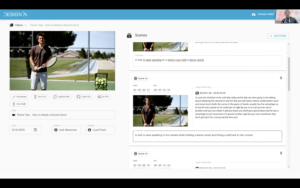Categories
Archives

Following on from our announcement of new accessibility-focused properties being added to the next version of IPTC’s Photo Metadata Standard, we are very happy to announce an additional speaker at this year’s IPTC Photo Metadata Conference: Andrew Kirkpatrick, Director of Accessibility at Adobe.
Andrew and his team define Adobe’s overall strategy for accessibility, attend to accessibility issues with product teams across the Adobe product line, and work with customers and standards groups, including representing Adobe on the accessibility-focused committees at the FCC, the United States Access Board, ETSI, and the World Wide Web Consortium. Andrew served as co-chair of the W3C’s Accessibility Guidelines Working Group and is an Editor for the Web Content Accessibility Guidelines 2.1 standard.
We are very excited about next week’s Photo Metadata Conference, which is taking place next Thursday, 4th November, from 1500 to 1900 UTC. Last year we had over 200 registrants, and this year we are on track to beat that number.
Accessibility features including live closed captions will be used at the event.
For those in timezones where the timing is inconvenient, please go ahead and register anyway – you will be sent a link to the event recordings afterwards.
There’s still time to register. Attendance is free of charge for anyone – there is no requirement to be an IPTC Member to join.
For full schedule details and a link to register, see the event page.
The latest version of the International Press Telecommunications Council IPTC’s Photo Metadata Standard includes two new properties: Alt Text (Accessibility) and Extended Description (Accessibility). These will make it easier for software companies, publishers, and website developers to make websites and electronic publications more accessible.
These new properties will be introduced to the public and discussed in detail at the IPTC Photo Metadata Conference, held online next Thursday, 4th November. Registration to the IPTC Photo Metadata Conference is free and open to all.
“A major milestone in accessibility is realised through the inclusion of embedded alt text and extended descriptions as IPTC metadata for digital images,” said Beth Ziebarth, Director of Access Smithsonian. “All publicly available images can now be made accessible. As with any good inclusive practice, this benefits a range of digital image users and producers. The foresight of the IPTC Photo Metadata Working Group is commendable.”
Web accessibility is mission-critical in our digitally inclusive age. As the number of images added to the web increases every day, the visual gap widens for people using assistive technologies, especially if they are blind. Embedding image descriptions for accessibility into photo metadata promises to be a game-changer, making it possible for software and systems to routinely provide alt text with images, thus giving screen reader software the ability to help readers visualise and listen to image descriptions as they are read out loud. Without accessible descriptions, images are silent for the millions who rely on screen readers to fully access the web.
As Richard Orme, CEO of the DAISY Consortium, has pointed out, “Up to 250 million people with blindness or moderate to severe vision impairment can benefit from image descriptions, plus countless more people with diverse information processing differences such as dyslexia who use text-to-speech technology for reading.”
The year 2020 was pivotal for web accessibility. Many disabled people were at high risk of severe illness from COVID-19 but struggled to access the essentials online — everything from healthcare and education to groceries and supplies. Inaccessible websites and applications have always been a barrier; during COVID, they became a threat to the health and safety of a vulnerable population.
Image descriptions are essential for people with visual impairments using assistive technologies and a fundamental requirement of the World Wide Web Consortium’s (W3C) Web Content Accessibility Guidelines (WCAG), the most widely-used guidelines for web accessibility in the world (W3C Web Accessibility Laws and Policies).
IPTC’s new accessibility properties will make it easier for platforms and software to comply with WCAG requirements and deliver images that are inclusive for everyone. Embedding accessible image descriptions into the photo metadata will make it possible for alt text and extended descriptions to travel wherever the image goes on the web or in books or other documents provided as EPUBs.
If you are interested, there are a few things you can do now:
- Attend the IPTC Photo Metadata Conference on November 4th to understand more about the new properties and how you can use them.
- Contact your software providers to tell them about these new properties and emphasise that these features are very important to you. Ask them when they will make the new properties available in their user interface.
- Contact your web content management software provider to make that case as well.
- For larger enterprises, think about how you could implement these properties into your organisation’s workflow.
The online IPTC Photo Metadata Standard specification will be updated to the new version on 4 November 2021.
IPTC members and our guests have just finished a very busy 2021 edition of our IPTC Autumn Meeting. Held online over three days, the meeting was a mix of IPTC Working Group presentations, members presenting recent projects, and invited guest speakers on important topics in the news and media world.
This year we heard member presentations from:
- Honor Craig-Bennett of the BBC reporting on the Images Digital Asset Management system, based on the Guardian’s open-source GRID system. We heard from Andy Read about this system
- Heather Edwards from Associated Press spoke about their project to replace their existing rules-based classification system
- Mark Milstein from Microstocksolutions spoke about a new project he is working on to create “synthetic media” AI-generated images and videos based on textual descriptions and metadata
- DATAGROUP Consulting Group’s Robert Schmidt-Nia spoke about a project using AWS’s Comprehend text classification service to power a serverless news classification system using IPTC’s Media Topics vocabulary
- Frameright‘s Marina Ekroos speaking about an EU stars4media project they are working on called “Artificial Intelligence in photojournalism: can it work?”
- Scott Yates from new Startup Member JournalList spoke about the trust.txt project, letting news providers state their affiliates and official social media channels in a simple way
- Bruce MacCormack from CBC / Radio Canada spoke about Project Origin, looking at authenticity for video and news media, passing requirements to the C2PA work
- The BBC‘s Charlie Halford spoke about C2PA, updating members with a deep technical view on how the system is planned to work, as detailed in the recently-released draft specification.
In addition, we heard from guest speakers:
- Keesiu Wong of Design AI spoke about the Videre AI project, looking at “next-generation video understanding”. He was joined by project partner Javier Picazo from Associate Member Agencia EFE, Spain’s national news agency.
- Alex Lakatos of Interledger spoke about the distributed payments technology which is used by…
- Uchi Uchibeke of Coil who use Interledger to implement micropayments which can be implemented on publisher websites by adding one line of HTML.
New standard versions
The Working Group presentations were also packed with content, in particular three new standard versions that were proposed to the Standards Committee:
- NewsML-G2 v2.30 adds fields for “residrefformat” and “residrefformaturi” to enable publishers to describe the format of a resource ID reference, and makes catalog and catalogRef optional to support publishers who only use URIs for controlled values and therefore have no need for catalogs
- The News in JSON Working Group’s ninjs v2.0 is a non-backwards-compatible new release which changes the way repeating values are handled, moving from patternProperties fields with arbitrary names such as “body_text” and “body_html” to arrays with fixed names such as “bodies”. The objects within the array elements include properties “role” and “contenttype” which take the place of the arbitrary extension to the “body_” tag.
- The IPTC Photo Metadata Standard v2021.1 adds new properties to IPTC Core which are intended to be used for accessibility purposes: “Alt Text (Accessibility)” and “Extended Description (Accessibility)”. We have also added and Event Identifier property to align with other metadata ID properties, and modified the Description Writer field to include the writer of the accessibility fields.
New faces
We were very happy to welcome new members Frameright, JournalList, Spotlight Sports Group, Glide Publishing Platform to the meeting.
The Standards Committee was chaired for the first time by new Chair Paul Harman of Bloomberg.
The AGM was the first for new Treasurer, Gerald Innerwinkler of Austria Press Agentur APA.
And we congratulate Philippe Mougin of Agence France-Presse AFP for being voted on to the IPTC Board of Directors, along with the existing Board members who were all re-elected.
It was another great meeting with over 70 representatives from 42 organisations in 17 different countries! We’re hoping that the next IPTC member meeting will be back to face-to-face, and we have provisionally booked Tallinn, Estonia for 16 – 18 May, 2022. We will confirm this in January 2022.
We are proud to announce the upcoming IPTC Photo Metadata Conference. This year’s event will be held online on Thursday 4th November 2021 as a Zoom webinar, free for anyone to attend, whether you are an IPTC member or not.
We are very happy to be hosting speakers from:
- the Smithsonian Institution, Macmillan Learning, Morey Creative Studios and Level Access speaking about accessibility for images on today’s web
- Adobe and the Content Authenticity Initiative speaking about content authenticity and provenance and the forthcoming C2PA specifications
- Michael Steidl from IPTC’s Photo Metadata Working Group introducing IPTC’s new tools to measure and compare the interoperability of photo metadata tools.
The event will run from 1500 to 1900 UTC, which is:
- 1500 to 1900 in the UK, Ireland and Portugal
- 1600 to 2000 in Central Europe
- 1700 to 2100 in Eastern Europe and Israel
- 1100 to 1500 in US East Coast
- 0800 to 1200 in US West Coast
- 2300 to 0300 in China
- 0200 to 0600 on Australia’s East Coast (sorry about that!)
See more information and register at https://iptc.org/events/photo-metadata-conference-2021/ or simply register using this link.
The webinar will be recorded, and those who register but can’t attend will be sent a link to the video so that they can watch the recording afterwards.
After registering, you will be emailed with a calendar invitation and a Zoom webinar link.
We’re looking forward to seeing you there!
Categories
Archives
- November 2025
- October 2025
- September 2025
- August 2025
- July 2025
- June 2025
- May 2025
- April 2025
- March 2025
- February 2025
- January 2025
- December 2024
- November 2024
- October 2024
- September 2024
- August 2024
- July 2024
- June 2024
- May 2024
- April 2024
- March 2024
- February 2024
- December 2023
- November 2023
- October 2023
- September 2023
- August 2023
- July 2023
- June 2023
- May 2023
- March 2023
- February 2023
- January 2023
- December 2022
- November 2022
- October 2022
- September 2022
- August 2022
- July 2022
- June 2022
- May 2022
- April 2022
- March 2022
- February 2022
- January 2022
- December 2021
- November 2021
- October 2021
- September 2021
- August 2021
- July 2021
- June 2021
- May 2021
- April 2021
- February 2021
- December 2020
- November 2020
- October 2020
- September 2020
- August 2020
- July 2020
- June 2020
- May 2020
- April 2020
- March 2020
- February 2020
- December 2019
- November 2019
- October 2019
- September 2019
- July 2019
- June 2019
- May 2019
- April 2019
- February 2019
- November 2018
- October 2018
- September 2018
- August 2018
- July 2018
- June 2018
- May 2018
- April 2018
- March 2018
- January 2018
- November 2017
- October 2017
- September 2017
- August 2017
- June 2017
- May 2017
- April 2017
- December 2016
- November 2016
- October 2016
- September 2016
- August 2016
- July 2016
- June 2016
- May 2016
- April 2016
- February 2016
- January 2016
- December 2015
- November 2015
- October 2015
- September 2015
- June 2015
- April 2015
- March 2015
- February 2015
- November 2014


